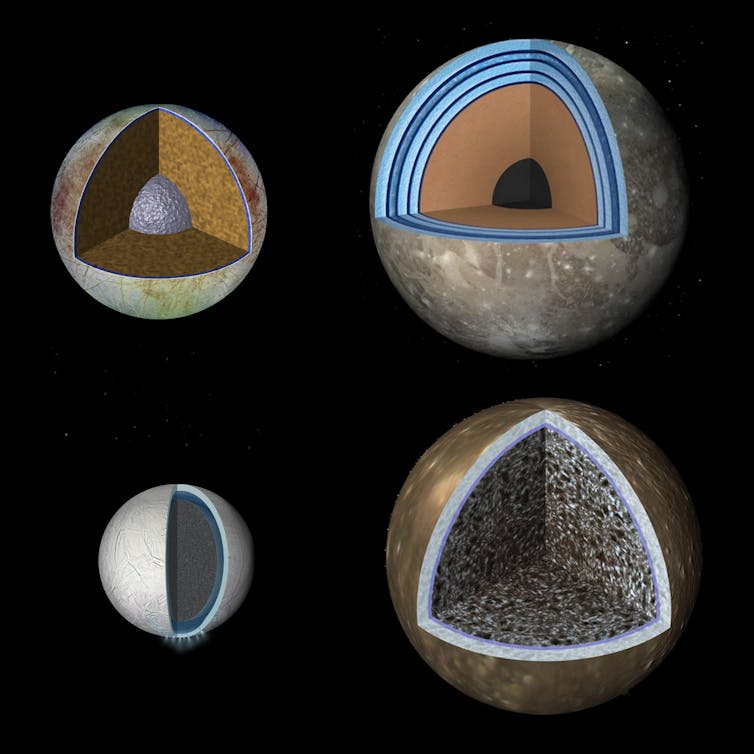The search for extra-solar oceans

Earth was long thought to be the only planet in our Solar System with an ocean, but it is beginning to look as though there are underground oceans inside even the most surprising icy bodies.
In fact, icy moons and dwarf planets in the outer Solar System appear to have liquid oceans below layers of thick ice. Recent research suggests there could even be oceans inside bodies beyond Pluto. That is surprising, as these bodies have surface temperatures way below -200°C.
Seventy years ago, it seemed plausible that Venus’s steamy atmosphere was hiding a global ocean from our view. This idea was scuppered in 1962 when the spacecraft Mariner 2 flew past Venus and found that its surface is too hot for liquid water.
It wasn’t long before we realised that any oceans that may once have been on Venus and also Mars vanished billions of years ago due to major changes in their climates.
Tidal heating
The revolution in thinking that paved the way for our new view of the Solar System’s oceans can be traced back to a 1979 paper by astrophysicist Stan Peale. This predicted that Jupiter’s innermost large moon, Io, would be so hot inside that it could be volcanically active.
The heat source that makes this possible is a gravitational effect – a repeated tidal tug between Io and the next moon out from Jupiter, Europa. Europa completes exactly one orbit for Io’s two. Io therefore overtakes Europa after every two orbits, receiving a regularly repeated tidal tug from Europa that prevents Io’s orbit from becoming circular.
This mans that Io’s distance from Jupiter is continually changing, and therefore so does the strength of the much stronger tidal force from Jupiter, which actually distorts Io’s shape.
Repeated tidal distortion of its interior warms Io by internal friction, in the same way that if you bend a stiff wire to and fro several times and then touch the newly bent part to your lip (try it with a coat hanger or a paper clip), you will be able to feel the warmth.
Peale’s prediction of tidal heating was vindicated only a week after publication when Voyager-1, the the first sophisticated flyby of Jupiter, sent back images of volcanoes erupting on Io.
Io is a rocky world, with no water in any form, so this may seem to have nothing to do with oceans. However, the Jupiter-Io-Europa tidal tug works both ways. Europa is tidally heated as well, not just by Io, but also by the next moon out, Ganymede.

The four satellites thought to have liquid water in our solar system – clockwise from top left: Europa, Ganymede, Callisto and Enceladus – and there may be more.
There is now very good evidence that between Europa’s icy shell and its rocky interior, there is a 100km-deep ocean. Ganymede may have as many as three or four liquid layers, sandwiched between layers of ice. In these cases, the heat that prevents the liquid water from freezing is probably mostly tidal in origin.
There is also evidence of a salty liquid water zone within Callisto, Jupiter’s outermost large moon. This isn’t likely to be due to tidal heating but instead possibly down to heat given off by decay of radioactive elements.
Saturn has a relatively small (504km radius) icy moon called Enceladus, which has an internal ocean thanks to tidal heating from interaction with the larger moon called Dione. We are absolutely certain that this ocean exists because Enceladus’s icy shell wobbles in a way that is possible only because this shell is not fixed to the solid interior.
Moreover, water and trace components from this internal ocean were sampled by the Cassini spacecraft. Its measurements suggested Enceladus’s ocean water must have reacted with warm rock below the ocean floor, and that the chemistry down there looks suitable for supporting microbial life.
Other oceans
Puzzlingly, even for moons that should have no tidal heating, and for bodies that aren’t moons at all, evidence for internal oceans keeps mounting up. The list of worlds that may have, or may once have had, internal oceans includes several moons of Uranus, such as Ariel, Triton, the largest moon of Neptune, and Pluto,

The best picture so far of Ariel
The closest internal ocean to the Sun may be inside the dwarf planet Ceres, though that is perhaps largely frozen by now, or may just consist of salty sludge.
Particularly amazing to me is indications of ocean worlds way beyond Pluto. These come from recently published results from the James Webb Space Telescope looking at the ratios of various isotopes (atoms that have more or fewer particles called neutrons in their nucleus) in the frozen methane that coats Eris and Makemake, two dwarf planets a little smaller and considerably more remote than Pluto.
The authors claim their observations are evidence of chemical reactions between internal ocean water and the ocean floor rock, and also of fairly young, possibly even present day, plumes of water. The authors suggest that heat from the decay of radioactive elements in the rock is sufficient to explain how these internal oceans have been kept warm enough to avoid freezing.

The potential range of conditions on Eris and Makemake.
You might wonder whether all this could boost our chances of finding alien life. It grieves me to spoil the party, but there were several papers at this year’s Lunar and Planetary Science Conference in Houston (March 11-15) reporting that the rock below the floor of Europa’s ocean must be too strong for faults to crack it apart to create the sort of hot springs (hydrothermal vents) on its ocean floor that fed microbial life on the early Earth.
It is possible that other underground oceans could be similarly inhospitable. But so far, there’s still hope.
This article was published by The Conversation UK. The headline photo is the best current image of Ariel, the fourth-largest moon of Uranus.
David Rothery became Professor of Planetary Geosciences at the Open University in the United Kingdom in November 2013, having been a Senior Lecturer in Earth Sciences since 1994.













